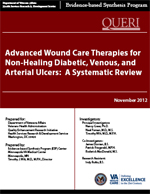
|
Principal Investigators:
Nancy Greer, Ph.D.
Neal Foman, M.D., M.S.
Timothy Wilt, M.D., M.P.H. Evidence-based Synthesis Program (ESP) Center
Minneapolis VA Medical Center
Washington (DC): Department of Veterans Affairs; November 2012 |
Download PDF: Complete Report, Executive Summary, Report, Appendices
Chronic ulcers (i.e., ulcers that are unresponsive to initial therapy or that persist despite appropriate care) are estimated to affect over 6 million people in the United States. The incidence is expected to increase as the population ages and as the number of individuals with diabetes increases. Chronic ulcers negatively affect the quality of life and productivity of the patient and represent a financial burden to the health care system. Within the Veterans Health Administration, during fiscal year 2011, there were over 227,000 ulcer encounters (inpatient and outpatient) involving over 54,000 patients and nearly 77,000 new ulcers.(Source: PAVE ProClarity Cubes (Prevention of Amputations in Veterans Every ProClarity Cubes)).
We focus on chronic ulcers of the lower extremity, in particular, ulcers attributed to either diabetes, venous disease, or arterial disease. Because advanced wound care therapies are typically used for ulcer healing following amputation, we also included post-amputation wounds. Identifying the ulcer etiology is important because the correct diagnosis is one factor in determining appropriate wound care interventions. Treatment modalities and wound care therapies are also selected based on patient factors, past treatment, and provider choice. A brief description of each ulcer type is provided below. We recognize that a non-healing ulcer is likely a result of multiple factors and comorbid conditions. We categorize included studies as diabetic, venous, or arterial according to the study author's description of the ulcer type.